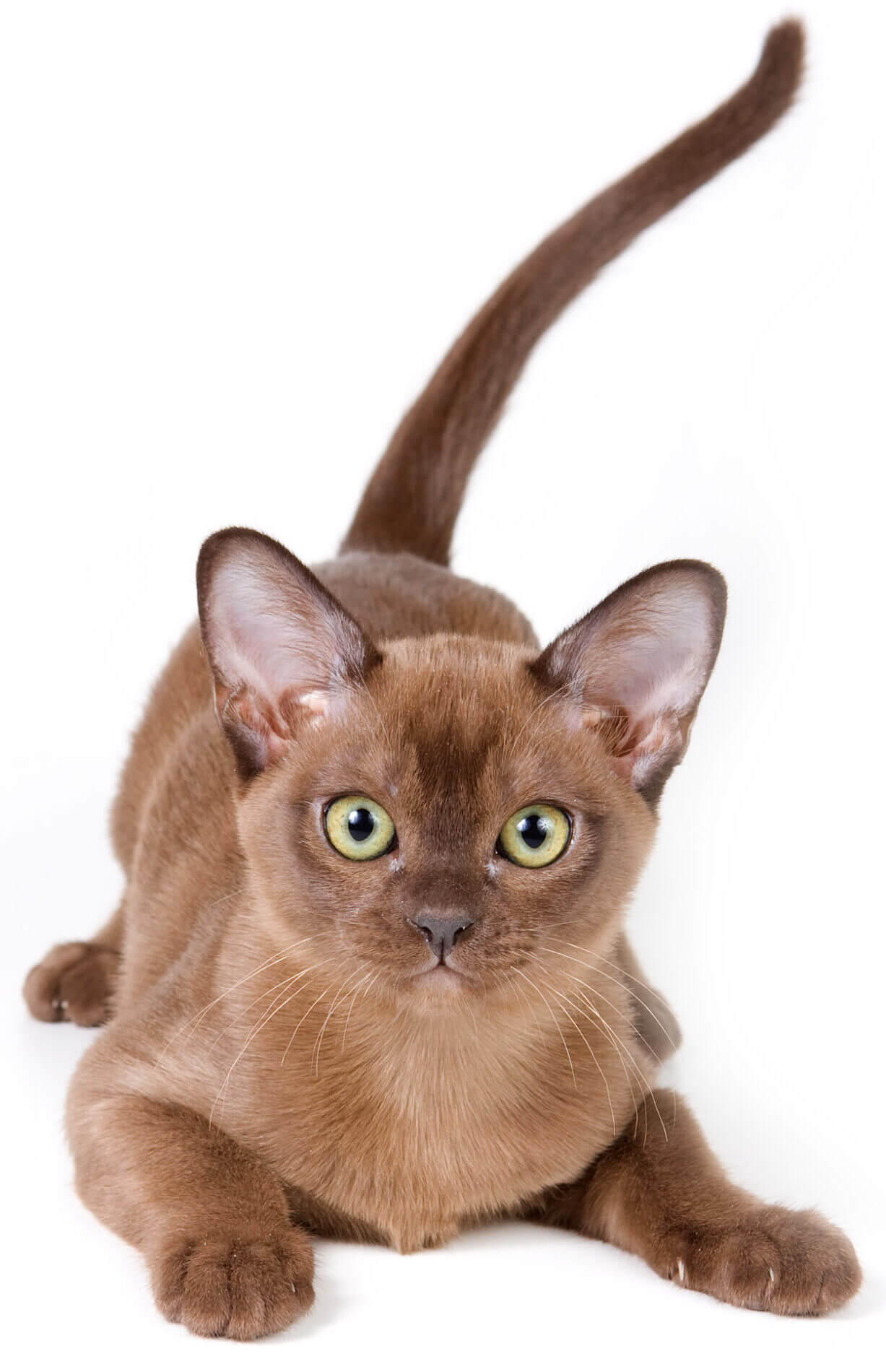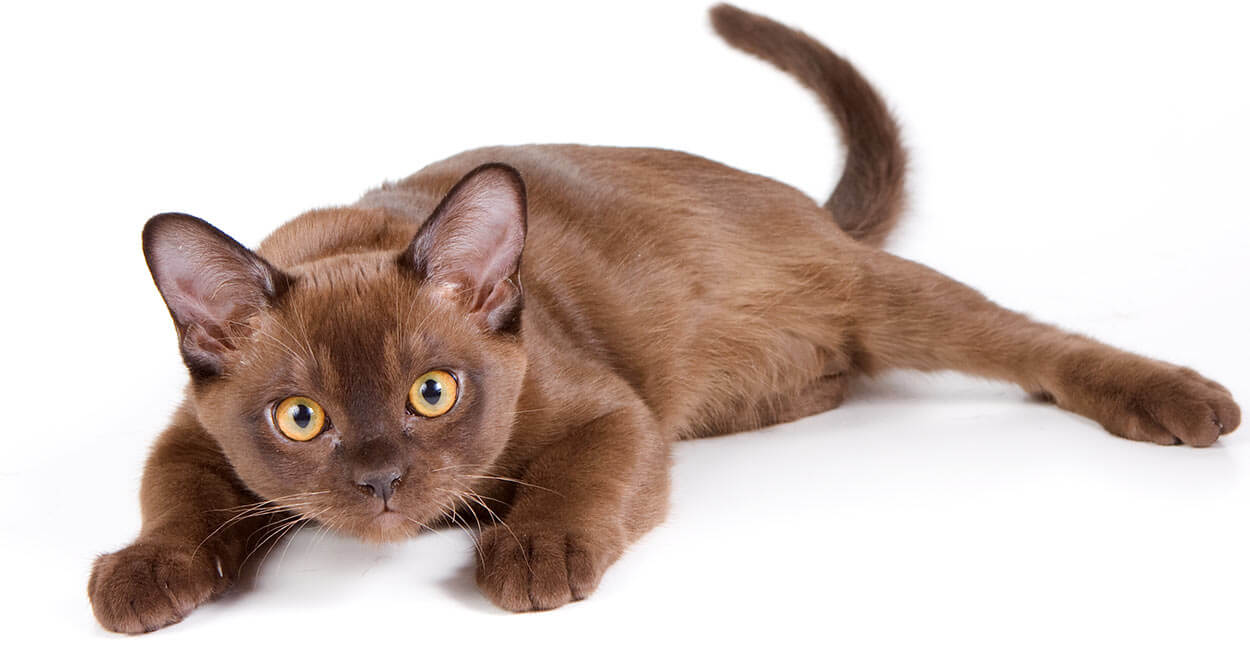History & Origin
History & Origin
Called copper cats in their native region for their rich brown colour, these cats have existed in Southeast Asia for centuries. They were described and depicted in the ancient text The Cat-Book Poems, a manuscript written in the city of Ayudha, Siam (now Thailand) sometime between 1350, when the city was founded, and 1767, when the city was razed by invaders.
Our modern Burmese breeding began in 1930, when a female cat was brought to the United States from Burma. The cat, named Wong Mau, had caught the fancy of a retired Navy doctor named Joseph Thompson. He took the cat to his home in San Francisco.
By breeding Wong Mau with Siamese Cats, Thompson determined that the Burmese was a distinct breed rather than a Siamese variant. The doctor began a carefully planned breeding program to establish the Burmese as a new American breed. Three colour variations were identified: medium brown with dark points, light brown with dark points, and solid, dark-chocolate brown. Thompson decided to work with the sable brown cats, as he felt they were the most beautiful and striking.
The breed was controversial from the start. Siamese breeders strongly opposed the breed; they considered Wong Mau a poorly coloured Siamese and didn’t want her “poor” genes muddying up their pure gene pool. Other cat lovers, however, immediately took to the look and personality of the Burmese.
The Cat Fanciers’ Association (CFA) first accepted the Burmese for registration in 1936, but because of the controversy and poor breeding practices, the CFA suspended the registration of the Burmese in 1947. Breeders worked to improve the breed. In 1953 the CFA reinstated the Burmese for recognition and in 1957 granted championship. Since then, the breed has been refined through selective breeding, and the three distinct body styles emerged.

Called copper cats in their native region for their rich brown colour, these cats have existed in Southeast Asia for centuries. They were described and depicted in the ancient text The Cat-Book Poems, a manuscript written in the city of Ayudha, Siam (now Thailand) sometime between 1350, when the city was founded, and 1767, when the city was razed by invaders.
Our modern Burmese breeding began in 1930 when a female cat was brought to the United States from Burma. The cat, named Wong Mau, had caught the fancy of a retired Navy doctor named Joseph Thompson. He took the cat to his home in San Francisco.
By breeding Wong Mau with Siamese Cats, Thompson determined that the Burmese were a distinct breed rather than a Siamese variant. The doctor began a carefully planned breeding program to establish the Burmese as a new American breed. Three colour variations were identified: medium brown with dark points, light brown with dark points, and solid, dark-chocolate brown. Thompson decided to work with the sable brown cats, as he felt they were the most beautiful and striking.
The breed was controversial from the start. Siamese breeders strongly opposed the breed; they considered Wong Mau a poorly coloured Siamese and didn’t want her “poor” genes muddying up their pure gene pool. Other cat lovers, however, immediately took to the look and personality of the Burmese.

The Cat Fanciers’ Association (CFA) first accepted the Burmese for registration in 1936, but because of the controversy and poor breeding practices, the CFA suspended the registration of the Burmese in 1947. Breeders worked to improve the breed. In 1953 the CFA reinstated the Burmese for recognition and in 1957 granted championship. Since then, the breed has been refined through selective breeding, and the three distinct body styles emerged.

Called copper cats in their native region for their rich brown colour, these cats have existed in Southeast Asia for centuries. They were described and depicted in the ancient text The Cat-Book Poems, a manuscript written in the city of Ayudha, Siam (now Thailand) sometime between 1350, when the city was founded, and 1767, when the city was razed by invaders.
Our modern Burmese breeding began in 1930, when a female cat was brought to the United States from Burma. The cat, named Wong Mau, had caught the fancy of a retired Navy doctor named Joseph Thompson. He took the cat to his home in San Francisco.
By breeding Wong Mau with Siamese Cats, Thompson determined that the Burmese was a distinct breed rather than a Siamese variant. The doctor began a carefully planned breeding program to establish the Burmese as a new American breed. Three colour variations were identified: medium brown with dark points, light brown with dark points, and solid, dark-chocolate brown. Thompson decided to work with the sable brown cats, as he felt they were the most beautiful and striking.
The breed was controversial from the start. Siamese breeders strongly opposed the breed; they considered Wong Mau a poorly coloured Siamese and didn’t want her “poor” genes muddying up their pure gene pool. Other cat lovers, however, immediately took to the look and personality of the Burmese.
The Cat Fanciers’ Association (CFA) first accepted the Burmese for registration in 1936, but because of the controversy and poor breeding practices, the CFA suspended registration of the Burmese in 1947. Breeders worked to improve the breed. In 1953 the CFA reinstated the Burmese for recognition and in 1957 granted championship. Since then, the breed has been refined through selective breeding, and the three distinct body styles emerged.
Welcome to Ramaal Burmese's world
JOIN OUR NEWSLETTER
Stay Up To Date With All The Latest News!
Welcome to Ramaal Burmese's world
JOIN OUR NEWSLETTER
Stay Up To Date With All The Latest News!